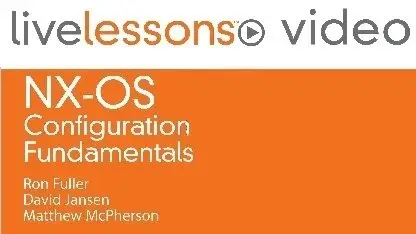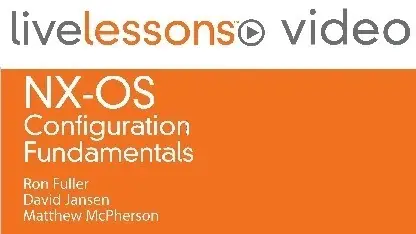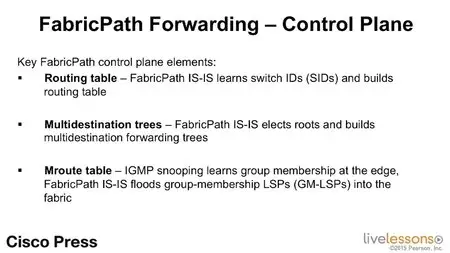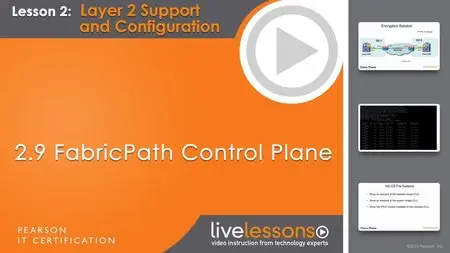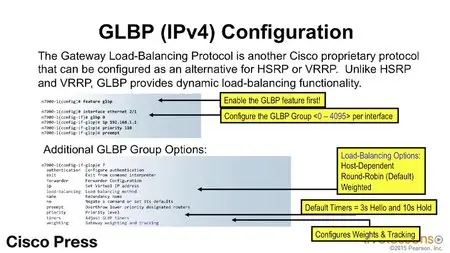NX-OS Configuration Fundamentals
English | Dec 26, 2014 | ISBN-10: 1587205645 | mp4 | H264 1280x720 | AAC 2 ch | 11 hrs 48 min | 2.83 GB
eLearning
English | Dec 26, 2014 | ISBN-10: 1587205645 | mp4 | H264 1280x720 | AAC 2 ch | 11 hrs 48 min | 2.83 GB
eLearning
Overview
12+ hours of video instruction on NX-OS technologies and configuration
Descripton
NX-OS Configuration Fundamentals LiveLessons is a unique video product that provides a solid understanding of NX-OS technologies across five product families. The product takes the student from an introduction to the product families and operating system, to Layer 2 and 3 capabilities before moving on to multicast and security. High availability, unique embedded serviceability features, and Unified Fabric and the Nexus 1000v are covered. Finally, QoS, OTV, MPLS, and LISP conclude the lessons. The most current updates in products and technologies have been incorporated, including OTV VLAN translation, L2 MPLS VPNs, LISP IGP assist, FabricPath multi-topology, and anycast HSRP, among many others.
NX-OS Configuration Fundamentals LiveLessons contains 13 individual video lessons, subdivided into 88 sublessons, for a total of 12 hours of instruction. The videos consist of audio instruction, animations, and video screencasts. Each video lab presents detailed objectives, lab diagrams, and video captures. Audio instruction throughout offers detailed explanations, tips, and configuration verifications.
The 13 video lessons cover the following topics:
* Introduction to NX-OS
* Layer 2 Support and Configurations
* Layer 3 Support and Configurations
* IP Multicast Configuration
* Security
* High Availability
* Embedded Serviceability Features
* Unified Fabric
* Nexus 1000v
* Quality of Service (QoS)
* Overlay Transport Virtualization (OTV)
* MPLS
* LISP
Skill Level
Beginning to intermediate
What You Will Learn
Provides an easy-to-use and cost-effective means to learn the various concepts associated with NX-OS technologies.
Provides multimedia tutorials that users can apply to real-world scenarios
Who Should Take This Course
Primary Audience:The target audience for this book is the network engineer or operator.
Secondary Audience: Help desk analysts or network administrators as well data center certification candidates. The students should be intermediate to expert level.
Course Requirements
These LiveLessons assume common knowledge of Cisco IOS and network switching and routing theory. The typical student should have at least a CCNP certification and should be responsible for configuration and day-to-day operations of enterprise-level data center switches. The users could also be responsible for planning the interconnect strategy for data-center devices.
Lesson 1: Introduction to NX-OS
Lesson 1.1: NX-OS Basics (10 minutes)
Lesson 1.2: NX-OS Command Line and Management (10 minutes)
Lesson 1.3: NX-OS File Systems (10 minutes)
Lesson 1.4: Nexus Product Updates
Lesson 1.5: Virtual Device Context (VDC) Fundamentals (10 minutes)
Lesson 1.6: VDC Advanced Topics (10 minutes)
Lesson 1.7: Troubleshooting Commands (10 minutes)
Lesson 2: Layer 2 Support and Configuration
Lesson 2.1: Layer 2 Basics (7-8 Minutes)
Lesson 2.2: Advanced Spanning Tree (7-8 Minutes)
Lesson 2.3: Port Profiles (5 Minutes)
Lesson 2.4: Port Channels (5 Minutes)
Lesson 2.5: Virtual Port Channel (vPC) Terminology Primer and Basic Configuration (5 Minutes)
Lesson 2.6: Advanced vPC Features (7 Minutes)
Lesson 2.7: vPC Failure Scenarios (5 Minutes)
Lesson 2.8: Layer 2 Best Practices (5 Minutes)
Lesson 2.9: FabricPath Introduction (7 Minutes)
Lesson 2.10: Advanced FabricPath (7 Minutes)
Lesson 2.11: FabricPath Troubleshooting (5 Minutes)
Lesson 3: Layer 3 Support and Configuration
Lesson 3.1: EIGRP Basics (7-8 Minutes)
Lesson 3.2: Advanced EIGRP (7-8 Minutes)
Lesson 3.3: OSPF Basics (7-8 Minutes)
Lesson 3.4: Advanced OSPF (7-8 Minutes)
Lesson 3.5: BGP Basics (7-8 Minutes)
Lesson 3.6: BGP Verification (7-8 Minutes)
Lesson 3.7: IS-IS (5 Minutes)
Lesson 3.8: First Hop Redundancy Protocl (FHRP) (10 Minutes)
Lesson 3.9: FHRP Interaction with vPC and FabricPath (7-8 Minutes)
Lesson 4: Multicast
Lesson 4.1: Multicast Basics (10 minutes)
Lesson 4.2: Protocol Independent Multicast (PIM) and Internet Group Management Protocol (IGMP) (10 minutes)
Lesson 4.3: Basic Multicast Configuration (10 minutes)
Lesson 4.4: Rendezvous Point (RP) Redundancy (10 minutes)
Lesson 4.5: Advanced Multicast Configuration (5 minutes)
Lesson 4.6: Control Plane Policing (CoPP) and Multicast (15 minutes)
Lesson 5: NX-OS Security
Lesson 5.1: NX-OS Security Basics (10 minutes)
Lesson 5.2: NX-OS TrustSec Basics (10 minutes)
Lesson 5.3: NX-OS TrustSec Advanced Topics (10 minutes)
Lesson 5.4: Access List Basics (10 minutes)
Lesson 5.5: Traffic Storm Control (5 minutes)
Lesson 5.6: Control Plane Policing (13 minutes)
Lesson 6: High Availability
Lesson 6.1: Nexus Hardware Basics (7-8 Minutes)
Lesson 6.2: Nexus Hardware Redundancy (7-8 Minutes)
Lesson 6.3: Generic Online Diagnostics (5 Minutes)
Lesson 6.4: NX-OS High Availability Architecture and Features (8 Minutes)
Lesson 6.5: NX-OS Software Upgrades – Cold Upgrade (5 Minutes)
Lesson 6.6: NX-OS Software Upgrades – ISSU Operation and Pre-Check (7-8 Minutes)
Lesson 6.7: NX-OS Software Upgrades – ISSU (7-8 Minutes)
Lesson 7: Embedded Services
Lesson 7.1: Switched Port Analyzer (SPAN) in NX-OS (10 minutes)
Lesson 7.2: Encapsulated Remote SPAN (ERSPAN) in NX-OS (10 minutes)
Lesson 7.3: Embedded Analyzer (10 minutes)
Lesson 7.4: Smart Call Home (10 minutes)
Lesson 7.5: Configuration Checkpoint and Rollback (10 minutes)
Lesson 7.6: NetFlow (10 minutes)
Lesson 7.7: Network Time Protocol (NTP) (10 minutes)
Lesson 8: Unified Fabric
Lesson 8.1: Unified Fabric Basics (10 minutes)
Lesson 8.2: FCoE Basics (10 minutes)
Lesson 8.3: N Port Virtualization Options (10 minutes)
Lesson 8.4: Unified Fabric Configuration - Single Hop (10 minutes)
Lesson 8.5: Unified Fabric Configuration - Multihop (10 minutes)
Lesson 9: Nexus 1000v
Lesson 9.1: Nexus 1000v Basics (10 minutes)
Lesson 9.2: Nexus 1000v Multi-Hypervisor Integration (10 minutes)
Lesson 9.3: Nexus 1000v InterCloud (12 minutes)
Lesson 10: Quality of Service (QoS)
Lesson 10.1: QoS Fundamentals (15 minutes)
Lesson 10.2: QoS in NX-OS (10 minutes)
Lesson 10.3: QoS on Nexus 7000 (15 minutes)
Lesson 10.4: QoS on Nexus 5000 (10 minutes)
Lesson 10.5: QoS on Nexus 1000v (10 minutes)
Lesson 11: Overlay Transport Virtualization (OTV)
Lesson 11.1: OTV Basics (10 minutes)
Lesson 11.2: OTV Network Requirements and Options (10 minutes)
Lesson 11.3: OTV Multihoming and Failure Isolation (10 minutes)
Lesson 11.4: First Hop Redundancy Protocol (FHRP) Localization and OTV (10 minutes)
Lesson 11.5: OTV Traffic Depolarization (10 minutes)
Lesson 11.6: OTV VLAN Translation (10 minutes)
Lesson 11.7: OTV Integration with Fabrics
Lesson 12: MPLS
Lesson 12.1: Virtual Routing and Forwarding (7-8 Minutes)
Lesson 12.2: Route Import/Export (7-8 Minutes)
Lesson 12.3: MPLS Basics (7-8 Minutes)
Lesson 12.4: Licensing and Hardware Requirements (5 Minutes)
Lesson 12.5: Advanced MPLS Topics (7-8 Minutes)
Lesson 12.6: MPLS Configuration (7-8 Minutes)
Lesson 12.7: MPLS and IPv6 (5 Minutes)
Lesson 12.8: MPLS Layer 2 VPN Basics (5 Minutes)
Lesson 12.9: MPLS Layer 2 VPN Configuration (5 Minutes)
Lesson 12.10: MPLS Management and Troubleshooting (7-8 Minutes)
Lesson 13: Locator ID Separator Protocol (LISP)
Lesson 13.1: LISP Basics (10 minutes)
Lesson 13.2: LISP Control and Data Plane (10 minutes)
Lesson 13.3: LISP Communication with Non-LISP Networks (10 minutes)
Lesson 13.4: LISP and Host Mobility (10 minutes)
Lesson 13.5: LISP Multihop (10 minutes)
Lesson 13.6: LISP Best Practices (10 minutes)
Lesson 1 Introduction to NX-OS
This lesson covers the history of NX-OS, platform support, command-line interface, file systems, VDCs, VDCs with advanced topics, and troubleshooting commands.
Lesson 2 Layer 2 Support and Configuration
This lesson covers Layer 2 functionality within NX-OS. This includes spanning tree, advanced spanning tree, port channels, virtual port channel, and FabricPath.
Lesson 3 Layer 3 Support and Configuration
In lesson 3, we explore Layer 3 topics including routing protocols such as EIGRP, OSPF, BGP, ISIS, and FHRPs.
Lesson 4 Multicast
Lesson 4 covers multicast-related topics including PIM, IGMP, RP redundancy, and advanced multicast configurations.
Lesson 5 NX-OS Security
This lesson provides an overview of NX-OS security basics, Cisco TrustSec, advanced topics with TrustSec, ACL basics, traffic storm control, and Control Plane Policing.
Lesson 6 High Availability
This lesson discusses NX-OS physical high availability, software high availability, ISSU, and GOLD.
Lesson 7 Embedded Services
This lesson discusses embedded services features, such as SPAN, ERSPAN, the embedded analyzer, Smart Call Home, checkpoint and rollback, NetFlow, and NTP.
Lesson 8 Unified Fabric
Lesson 8 covers Cisco Unified Fabric, including FCoE basics and NPV as well as both single and multihop FCoE configurations.
Lesson 9 Nexus 1000v
This lesson covers the Nexus 1000v, including an overview, Multi-Hypervisor integration, and InterCloud.
Lesson 10 Quality of Service (QoS)
Lesson 10 discusses QoS fundamentals, Nexus 7000, Nexus 5000, and Nexus 1000v.
Lesson 11 Overlay Transport Virtualization (OTV)
This lesson reviews OTV starting with an overview, then network requirements and options, multihoming and failure isolation, FHRP localization, traffic depolarization, VLAN translation, and integration with next-generation fabrics.
Lesson 12 MPLS
Lesson 12 covers VRF functionality, licensing and hardware requirements, LDP and L3 and L2 VPNs as well as IPv6 and MPLS management and troubleshooting.
Lesson 13 Locator ID Separator Protocol (LISP)
Lesson 13 covers LISP starting with an overview, then the LISP control plane and data plane, communication with non-LISP networks, host mobility, multi-hop, and LISP best practices.
Screenshots:


